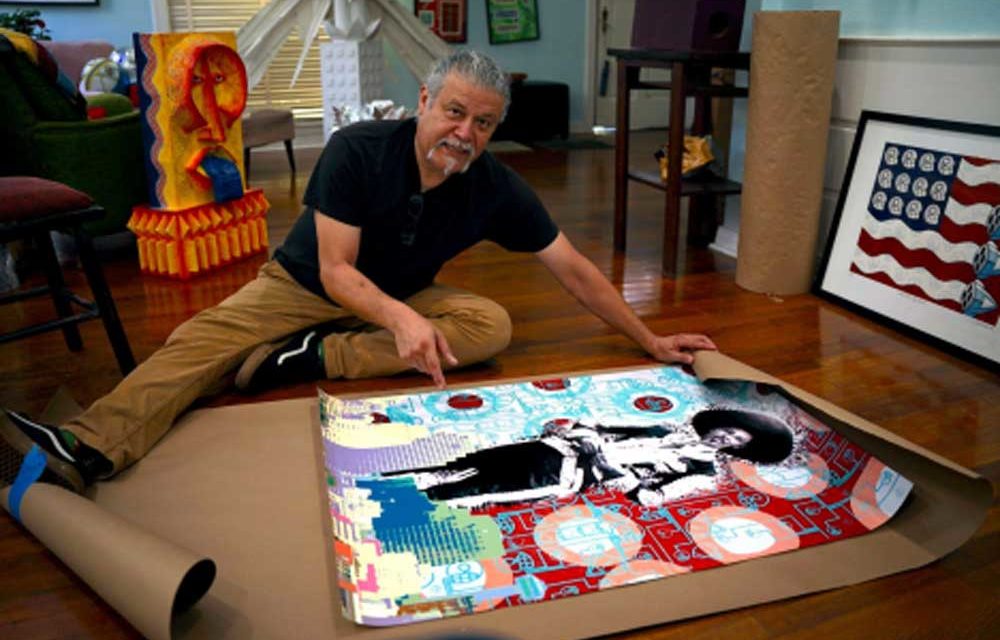Luis Valderas traces his artistic development to his early years working in the family-owned flower and ceramic shop in McAllen, Texas near the U.S.-Mexico border. During his time away from school, he joined his brothers and sister in manufacturing flower arrangements and making ceramic figures to sell in the family shop. For Day of the Dead and other important religious festivals, the Valderas family traveled along the busy South Texas highways picking up freshly cut grass to tie in narrow bundles to create the foundational base of funeral wreaths.
Valderas’s formal training as an artist began in middle school and continued through high school. Although he earned praise from his teachers for his artistic talents, he did not consider pursuing art as a career until several years after graduating from high school. Valderas enrolled at Pan American University in Edinburg after finishing high school and worked part-time as a commercial artist in a local food chain store. During his second year of college “La Musica” hit him, disrupting his plans to complete academic studies. The “La Musica” episode consisted of Valderas joining three neighborhood friends in forming a rock and roll band. They named their musical group “The Rockoons.”
The “Rockoons” left the Rio Grande Valley in the late 1980s chasing a dream of musical fame and fortune. Their van, border patrol green, broke down in Dallas on their way to a possible record deal in Minnesota. The Rockoons remained in Dallas for a year playing in small music venues. Valderas maintained his dedication to art training by enrolling at a Dallas art institute. Valderas and his fellow Rockoon members gave their shaky musical endeavor a year, then decided a music career would not be productive.
Valderas returned to McAllen and re-enrolled in art classes at the Pan American Univesity campus in nearby Edinburg. While working on his BFA in the mid-1990s, Valderas studied with Art Professor Richard Hyslin who recruited him and several other students to help in the construction of a 50-foot metal and concrete sculpture of Our Lady of Guadalupe–the largest statue of the Mexican Virgin in the world. Valderas worked in Edinburg in the welding sections of the statute and traveled with Professor Hyslin to the Catholic center in Winsor, Ohio where they added the metal mesh and concrete to the huge art piece.
Following his graduation from Pan American University, Valderas took a position teaching art at Lamar Middle School in his hometown of McAllen. In 2000, Valderas and his college friend and fellow artist, Xavier Garza, began making trips to San Antonio to attend art shows and participate in Latino art exhibitions. They found notable interest in Chicano art at the Guadalupe Cultural Center, Centro Aztlan, and Southtown, home to Andy Benavides’s South Flores gallery and Joe Lopez’s Gallista Gallery. That year Valderas and Garza moved permanently to San Antonio.
Valderas had been introduced to large-scale art projects in college, notably the construction of the 50-foot Lady of Guadalupe statue. In San Antonio, Valderas collaborated with his wife Kim Bishop and fellow artist Paul Karam in the production of dozens of large prints [9×5 feet] using industrial street paving rollers to press the Lenox cotton on carved wooded panels. The team of Bishop, Karam, and Valderas produced enough prints to lay across the 100-yard football field of Alamo Stadium.
Some modern Latino painters, such as Luis Valderas and a few of his colleagues, have conceptualized new ideas and subjects that touch on space, inter-planetary travel, and encounters with unworldly aliens. Artists have dealt with fantasy, exaggeration, and aspects of the mystical world since the era of cave paintings 30,000 years ago. The painting of angels, devils and the creator himself are images common to many cultures.
Bringing together early Indigenous imagery and contemporary cultures, Project MASA, which Valderass co-founded with Paul Karam in the early 2000s, is one of his most ambitious undertakings. MASA is an acronym for “MeChicano Alliance of Space Artists.” In his artist statement, Valderas wrote: “I make work that is based on Meso-American mythology intermingled with science fiction, outer space, and stories of my ancestors.” UCLA Chicano Studies’ publication Altermundos-Latin@ Speculative Literature, Film and Popular Culture and Arizona State University’s publication, Triumph in Our Communities: Four Decades of Mexican American Art featured his space work.
Valderas’s goal is to bring together Chicano and Latino artists from San Antonio and South Texas “who broadly engage speculative themes of outer space and the
otherworldy, the modern and technological, the utopian and dystopian.”
Project MASA V, featured in a recent exhibit at the Centro Cultural Aztlan, was curated by University of Texas-Rio Grande Valley Dr. Cathryn Merla-Watson and University of Texas-San Antonio graduate student Illiana Pompa. The curators gathered Chicano/a artists “that use outer space and science fiction iconography with past, present, and future tropes to comment on social-political issues” that affect La Raza.
In addition to his creative artwork, Valderas is known for his dedication to teaching and the mentorship of young students. He has taught art at Tom C. Clark High School for the past 22 years and serves on the Executive Board of the New York Foundation for the Arts [NYFA]. Valderas also mentors in NYFA’s special Immigrant Artist Program dedicated to the pairing of immigrant artists with artists’ mentors.
Currently, Valderas is working on a series of sculptures for September exhibits at UTSA and ArtPace and a follow-up to a large artistic rending of his father on the exterior wall of the Hyatt Regency Hotel parking structure on San Antonio’s Riverwalk. His public art includes new digital and technology tools that enable him to create larger-than-life portraits of people he admires. His work, whether on paper or digitally painted on a three-story public space, is highly creative, and there are no limits to the heights and spatial horizons of his talents.
Luis Valderas: A Futuristic Latino Artist









